Microlighting
The Early Years - Part 2
By Gerry Breen
1979
Whist awaiting the August deadline for the London to Paris flight I decided to have a crack at the World distance record for powered hang gliders using the Carrefour sponsored machine. I had heard that Larry Mauro in America had done 101 miles on an Easyriser and I was confident that I could beat it. My longest flight to date had been 52 miles from Wells in Somerset to the Hunt’s home in Wales. I had only done this as a last minute adventure after giving an air display in Wells. To my knowledge this was also the longest flight on a powered hang glider in the UK at the time.
The attempt was on Wednesday 18th April 1979 from the Wrekin hill near Shrewsbury. I had cut a map into a long strip that was put on a roller, which during the flight I could unwind as the journey progressed. The flight started off well but after about 90 miles I experienced severe vibration, which caused various nuts and bolts to fall away from the power unit, resulting eventually in a drive shaft failure. I landed next to the motorway at Thorne near Scunthorpe having covered exactly 98 miles - just 3 miles short of the record. With the experiences gained, Steve and I reinforced the drive shaft, wire-locked and applied Locktite to just about anything that risked coming undone. I reckoned at the time that we needed a clutch unit to remove the shock loadings on the drive shaft but this would have meant a complete redesign of the system.
At 11.19 on the morning of Monday 7th May I departed Abertysswg, South Wales heading for a declared goal of Norwich Airport, a distance of 202 miles. After about 50 miles the engine, which had been tuned at takeoff, started to run rough and I realised that it might soon stop if I didn’t retune it. The only way that I could get to the carburettor involved an idea that I had never put into practice before. I came out of the prone position, transferred from the hand to the mouth throttle and climbed up into the control frame to retune it whilst simultaneously keeping control by moving my weight inside the frame.
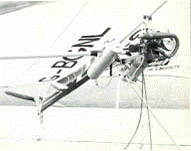 |
The Super Scorpion power unit and extra fuel tanks.
Steve and I had agreed that he would drive to Sywell Aerodrome and, if he saw me fly overhead, he would then continue the long road journey to Norwich. He later told me that as I passed overhead the wind was 25 kts gusting 35 kts and a helicopter pilot had said that nothing was flying that day! Arriving at Norwich Airport boundary after a flight of almost 4 hours, I ran out of fuel and landed just short of the tower and the assembled media. I was given permission to takeoff again so that the television cameras could re-film the landing. As I had flown ahead of a fast moving frontal system the weather was now deteriorating, becoming very gusty and raining. I settled for a quick takeoff, short hair-raising flight and a quick landing. The flight was headline news being featured on all the news stations that evening and newspapers the next day. However, Steve and I realised that we had little chance of capitalising on it as the aircraft was just too difficult to fly and, therefore we could not sell them to the general public.
Spurred on by the success of the flight, I set about planning the finer details of the London to Paris flight. I had heard a rumour that Len Gabriels and Brian Milton were also going to attempt it and hoped that they would not be ready until after my planned start date. Hiway Hang Gliders built me a beautiful Super Scorpion wing with the British Airways design incorporated into it.
In late July, Steve and I visited Oshkosh, USA for the annual EAA meet to catch up on the latest developments in the ultralight scene. There was a crude array of powered hang gliders on show and we reckoned that our powered Super Scorpion would have given them all a run for their money. I went to Rhode Island in order to get some training before attempting to fly my new autogyro when I got back. I was taught to fly on a towed gyro glider, which proved to be an invaluable experience and inspired me to use this method in order to teach people to fly the Eagle in the following year.
Upon my return I continued flying my autogyro. It was after experiencing severe vibration, virtually losing control, plummeting to the ground and landing extremely heavily that I discovered that the wooden and glass-fibre blades had started to warp and delaminate. This required a new set of blades – quite an expense at the time. Then I had a thought - why didn’t I try to fit a large reinforced hang glider to the remaining undercarriage frame and engine instead. Excited, I explained my concept to Steve. He seemed unimpressed with the idea and indicated that he felt the powered hang glider had a limited future and his efforts would be concentrated in the development of a proper three axis aircraft.
For the London to Paris flight I wanted to take off at the departure site of the original first commercial flight – Hendon, but the area had too much congestion. Concerned about the relative unreliability of the unit and the bits that kept falling off, I wanted a wide-open space south of London so opted for Biggin Hill, technically not the City but did it matter? Departing Biggin Hill on 25th August, I arrived 1hr 50 minutes later at the old wartime airfield of Hawkinge. However, I discovered that the drive shaft had again fractured around the propeller bolt-hole. As the shaft extended well beyond the last bearing, I simply sawed it off and drilled a new propeller-mounting hole. I calculated how much time the engine had run since the last fracture and reckoned it would see me across the English Channel.
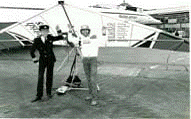 |
Gerry poses in front of Concorde.
The next leg of the journey, to Le Touquet, was therefore the most worrying. The RAF had unofficially said, that if they happened to be in the area and were not on call-out, they might accompany me. Brian Gaskin was acting as surface support but the seas were so rough that I quickly left him and his boat behind. I was feeling very vulnerable when a bolt (from the exhaust pipe, I later found out) landed on my map holder. Fear set in as I wondered if I might have to put down in the sea then suddenly a Wessex helicopter came into view. The crewman waved from the open doorway and this gave me an immense feeling of relief. I made Le Touquet without further mishap in 48 minutes and, after an overnight stop, I was getting ready for departure when I encountered engine problems and I was also told the news that I was being chased by Len Gabriels in the Bluebird Toffee-sponsored Skyhook Safari. Unfortunately this was turning into the race I didn’t want and I wasn’t going to be beaten after all this effort. I got no further than a few miles en route when the drive shaft failed yet again and I forced landed in a cornfield at Conchet Le Temple.
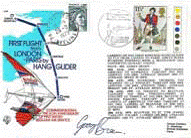 |
The first Royal Mail to be carried by powered hang glider.
I was really distraught and fully expected to be overtaken at any moment. I managed to get it repaired, by a local blacksmith who was also a pilot, and was soon taking off for Abbeville. After refuelling quickly I continued on to Beauvais even though it was quite late and the forecast was bad. I was delayed by a severe thunderstorm and, therefore, arrived in the dark; elated, knowing that it would be difficult to catch me now that I had flown so far in one day. The next morning, I departed and was met at St Cyr 1 hour 40 minutes later by a large crowd. British Airways and the RAF Museum had pulled out all the stops on their massive publicity machine. The flight was covered by most of the news channels and was the front cover story of most of the daily newspapers. On arrival in France, and unknown to me at the time, Len had initially been grounded at Le Touquet and again later, 65 miles north of Paris, because they said he had not obtained the required authorisations.
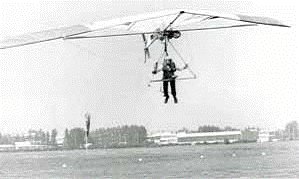 |
Gerry arrives at St Cyr near Paris.
Powered Hang Gliding continued to grow and the British Powered Hang Gliding Club had now been in existence for nearly a year. There were many exciting things happening with powered hang gliders and ultralights. Quite a few people had made their own engine units. Rob Jakeway had a Vega 1 with a direct drive unit and was making a Suzuki engined unit for a Super Scorpion. Paul Baker, David Garrison and David Kirke returned from the USA with Pterodactyl’s, (Fledgling hang glider conversions) which had tricycle undercarriages so that foot launching was no longer the only option.
The increased publicity and gain in popularity led to concern by the BHGA that the CAA would legislate all activities including hang gliding. The BHGA wrote to the CAA asking for clarification of the legal situation. Their reply stated that powered hang-gliders were aeroplanes and as such pilots should hold licences; the machines should be registered and have certificates of airworthiness or permits to fly. None of these requirements were being satisfied and the situation needed regularising. However the requirements would not be imposed provided the aeroplane’s weight, including engine and fuel, did not exceed 50 kg. This weight was selected as being a reasonable maximum for a machine, which a person could launch without the aid of some form of under-carriage, and would encompass all existing types of powered hang-gliders. Should mini-aeroplanes above that weight come on the scene, it would be open to the Authority either to apply existing requirements or to deal with them by exemption or by developing specific requirements as appropriate.
Steve Hunt, in his annual report of October 1979, stated that many powered hang gliders were outside the 50kg category and he proposed that the interests of the British Powered Hang Gliding Club be extended to cover aircraft up to an all-up weight of about 200 kg, however, during the AGM a 100 kg empty weight limit was accepted instead. This would possibly move the interests of the Club away from pure powered hang gliders, therefore two further proposals were to be put to the AGM, by the retiring Committee:
1. The name of the Club should be changed to The British Minimum Aircraft Association (Steve suggested the name as he was Australian and liked their term. However, I felt that it implied minimum everything: strength, safety, performance etc.)
2. The Club should cease to be a Member Club of the BHGA.
These proposals were accepted at the AGM on 18 November 1979 and the British Powered Hang Gliding Club became the British Minimum Aircraft Association. This sets the record straight: - the BMAA evolved from the British Powered Hang Gliding Club.
The above decisions did not take into account the reaction of the CAA and it soon became apparent after preliminary discussions that certain divisions within the Authority did not want to amend the ANO even for aircraft under 50 kg! It was felt, therefore, that to push for a deregulated 100 kg empty weight was premature. This didn’t stop progress as pilots continued to develop and fly whatever they could.
In October I became very excited when I picked up a Vol Libre magazine and saw exactly what I had envisaged. On the front cover was a picture of Roland Magallon’s hang glider wing and ‘autogyro type’ undercarriage. I raced up to the Hiway factory in order to show it to Frank Tarjanyi a friend of mine who worked there. He was very enthusiastic and agreed to help me develop one. I asked Steve if he would object to Frank helping me in his spare time and he said it would be fine providing it didn’t interfere with his work on the production of hang gliders. However, soon after work started Hiway saw its potential and it became a factory project.
1980
This was year zero for microlighting. We had a new regular publication called Flightline, two new revolutionary aircraft were about to be introduced and a new name for our activity and Association was ‘invented’.
In early January, Soarmaster invited me to an introductory course on a new powered hang glider, designed by Horst Honacker and Romauld Drlik, and marketed by Larry Newman of Electra Flyer. They stated that the aircraft could take off using its wheels, as well as be foot launched in order to meet the American regulations. They also claimed that there had never been an easier aircraft to fly and it was virtually unstallable. The Eagle Aerolight, I thought, the most ugly aircraft I had ever seen. It was controlled in pitch with a mixture of weightshift and canard elevator, a steering bar and tip rudders for turning. Powered by the original Soarmaster power unit, it gave very limited performance but was very easy to fly and everyone on the course managed to fly it without mishap. For the first time, I felt, I could get complete beginners flying safely. I bought one of the prototypes with which to start a marketing campaign upon my return the UK.
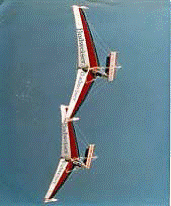 |
Eagles in formation.
I thought that the name ‘microlight’ summed up the aircraft better than Larry’s new name ‘aerolight’ and discussed this with Brian Harrison who was an Electra Flyer dealer from Scotland. After all it was small (micro) and also light, so what better word was there to use? In the USA, most powered hang gliders were being referred to as ‘ultralights’. I told him that, upon my return to the UK, I would refer to it in any publicity as a microlite or microlight and Brian decided to do the same. Looking back now, through the first five Flightline magazines, only Brian and I referred to them as microlight aircraft.
On 31st January, the Committee of the newly named British Minimum Aircraft Association had talks with the CAA in London. The outcome of the meeting left the Committee feeling that, unofficially, single seat aircraft up to 100kg and two seaters up to 120kg would be allowed to be self regulated. However, they were left in no doubt that the CAA would intervene if the sport got out of control.
I set about promoting the Eagle and was invited by Julian Grant to take part in a film called the Great North Face Air Race in Kliene Schidegg, in Switzerland. He wanted two Eagles and two Pterodactyls to take part and they needed to be converted to fly on skis. I invited George Wrzesien a friend of mine to fly the other Eagle and David Garrison and Paul Baker flew their Pterodactyls. One film became two: one was a fictitious race along the north face of the Eiger and the other was an altitude challenge called 3 Miles High.
The filming was great fun. We even got permission from the notoriously bureaucratic Swiss Aviation Authority who came to watch the filming. Unfortunately, after hearing the extreme noise level from the Cuyuna-driven high revving propellers of the Pterodactyls, echoing through the peaceful tranquillity of the alpine valleys, they decided, once filming had ended, that no more microlighting would take place in Switzerland. I was unaware of this until I applied for permission to make a television commercial on Lake Thun in 1982 and was told in no uncertain terms that microlight aircraft were not welcome. I eventually received authorisation to taxy my Eagle floatplane on the lake but flying was completely out of the question. It is interesting to note that the ban on microlights has only recently been lifted.
On 1st March, at Wellesbourne airfield, from where David and Paul operated, Hiway made their debut with the Skytrike, the machine that Frankie and I had initiated. The aircraft consisted of a Valmet 160cc engine and tricycle undercarriage assembly attached to a Super Scorpion wing, which gave reasonable performance - it certainly beat running for takeoff. Now it seemed there were so many different ways to fly a ‘minimum’ or microlight aircraft. There were two axis aircraft such as the Quicksilver and Weedhopper; the Eagle and Pterodactyl with their mixture of
weightshift and tip dragger controls; and the foot or wheel launch powered hang gliders. The main problem, however, was training beginners as, apart from the Eagle, most aircraft of the day were relatively unforgiving. I experimented with tow training on the Hiway Skytrike but the aircraft proved to be difficult to handle due to its poor directional stability.
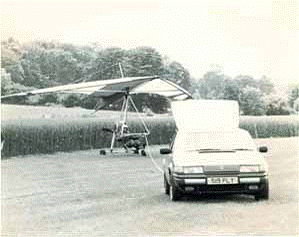 |
Tow training experiment with the Skytrike.
In May, the Secretary of the BMAA and head of the Dangerous Sports Club, David Kirke, attempted to fly non-stop from London to Paris in his Pterodactyl and ended up crashing into trees shortly after take off. Unfortunately, the Daily Mail covered the story, once again creating adverse publicity for our fledgling sport. The controversy resulted in his resignation as BMAA Secretary.
On 7-8 June the BMAA held it’s first fly-in at Wellesbourne. Frank Tarjanyi and Gordon Faulkner amazed all those present by flying in on Skytrikes from the Hiway factory in Wales. Nic Wrigley turned up with what I believe was Britain’s first two seat microlight - his own design of trike with a Solar Storm wing. I bought one from him but it was just as noisy as the Pterodactyl and after using it for only one day I was told to vacate the premises at Preston Cross airstrip. The meet attracted the attention of local counsellors who were busy pointing noise meters at the various aircraft in order to obtain readings. This was an ominous sign of future problems, not only for Wellesbourne, but for the sport as a whole.
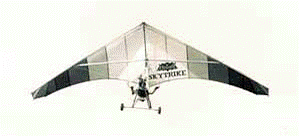 |
The first Hiway Skytrike.
On 22nd July David Garrison and John Leigh-Pemberton made the first flight from Lands End to John O Groats in their Pterodactyls. They completed the marathon four-day, 730 mile journey in 17 hours and 5 minutes total flying time. This inspired me to ask Carrefour, to sponsor a race over the same route, and on Monday 11th August the very first microlight race in Britain got underway. Out of the 20 expected pilots, only 7 turned up for the start: I had decided to use the latest Hiway Vulcan Skytrike; Bill Allen was using a Solar Storm with Skytrike, Ian Hoad and Paul Bennett had Flexiform Highlanders with Skytrikes; Les Ward had a Solar Storm Buggy; Dave Thomas a Hiway Skytrike with Super Scorpion Wing; and Ashley Doubtfire a Birdman Cherokee with Skytrike. After three days hard flying, averaging only 25 miles per hour, I made it to John O’Groats. Les Ward deserved a medal as he had crashed his aircraft during the first leg of the journey and still managed to rebuild it arriving a close second. A mixture of mechanical or weather problems and fatigue plagued the rest of the participants and therefore no one else made it. I came to the conclusion that races were going to have to be much shorter if we were going to get any serious participation in the future, as the machines, and most of the pilots of the day, just weren’t up to this length of journey.
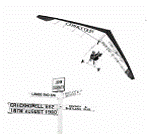 |
Gerry – first across the finish line at John O’Groats.
Autumn 1980 saw the publication of the first British Microlighting Book: Ultralight Aircraft in the Air written by Brian Cosgrove, which was the forerunner of The Microlight Pilots Handbook.
I needed a new long-term base for training and sales of the Eagle. After a few weeks research and lots of mileage Julian Doswell, one of my gifted hang gliding instructors, ‘discovered’ Enstone Airfield. A meeting was arranged with the owners and also the tenant farmer, Gordon Markham. His first question was “are your things as noisy as those at Wellesbourne”? I, of course, replied that they weren't, but he insisted that I did a demonstration to prove how quiet they were. Satisfied that the noise levels were acceptable, I was granted a 25 year lease on a plot of land and arranged for the construction of a 3000 square foot hangar, which doubled in size due to an unforeseen boom resulting from a four-page spread in the November issue of the Sunday Times Colour Supplement.
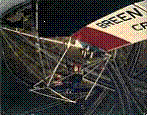 |
Gerry and Eagle over the M$/M5 Motorway (photo Peter Marlow)
Julian and I were featured flying the Eagle Microlight and Skytrike over the M4/M5 Motorway intersection at Almondsbury and the Bristol Channel, which caused a sensation. Coincidentally, it was published on Sunday 30th November, the same day as the AGM. On the way to Coventry, I bought 200 copies and, instead of rigging an Eagle for display, I set up a newsstand and sold the newspaper instead. The article was all the publicity we needed. We were inundated with literally thousands of enquiries. Orders rushed in from customers who couldn’t write out their cheques quick enough. My only concern was could Larry Newman keep up with the demand?
Julian Doswell and Eagle over the Bristol Channel (photo Peter Marlow).
I had kept plugging the word ‘microlight’ at every opportunity, so much so that, by the end of 1980, most people had stopped calling them minimum or ultralight aircraft. At the AGM, the Association decided, unanimously, to change its name tothe British Microlight Aircraft Association.
© Copyright Gerry Breen










